Maple Leaf Gardens
Maple Leaf Gardens is a historic building located at the northwest corner of Carlton Street and Church Street in Toronto, Ontario, Canada. The building was initially constructed as an arena to host ice hockey games, but has since been reconstructed for other uses. Today, Maple Leaf Gardens is a multi-purpose facility, with Loblaws occupying retail space on the lower floors and an arena for Toronto's Ryerson University, known as Mattamy Athletic Centre at the Gardens, occupying the top level.[5][6]
“The Carlton Street Cashbox” ”The Church of Hockey” MLG ”The Shrine” | |
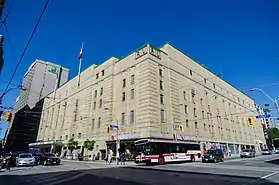 | |
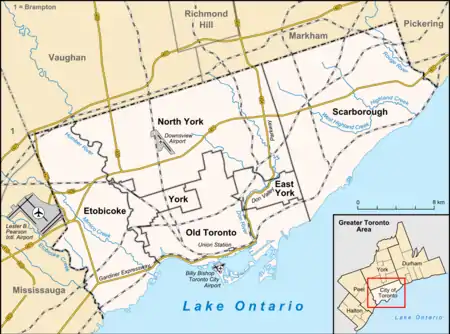 Maple Leaf Gardens Location in Toronto 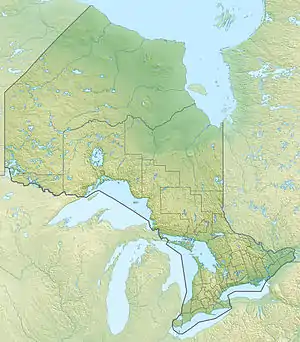 Maple Leaf Gardens Location in Ontario  Maple Leaf Gardens Location in Canada | |
| Address | 60 Carlton Street |
|---|---|
| Location | Toronto, Ontario |
| Coordinates | 43°39′44″N 79°22′49″W |
| Public transit | College Station 506 Carlton |
| Owner | Ryerson University Loblaw Companies Ltd. (2004-Present) Former owner Maple Leaf Gardens Ltd. (1931-2004) |
| Operator | Ryerson University Loblaw Companies Ltd. (2004-Present) Former Operator Maple Leaf Gardens Ltd. (1931-2004) |
| Capacity | Ice hockey: 12,473 (1931–1940),[1] 12,586 (1940–1960)1,[1] 13,718 (1960–1966)2,[1] 15,461 (1966–1968)3,[1] 16,316 (1968–1981)4,[1] 16,182 (1981–1991)5,[1] 15,642 (1991–1992),[1] 15,720 (1992–1993),[1] 15,728 (1993–1994),[1] 15,646 (1994–1996)6,[1] 15,726 (1996–2012),[1] 3,850 (2012–present) 114,550 with standing room 214,650 with standing room 316,161 with standing room 416,485 with standing room 516,382 with standing room 615,746 with standing room |
| Construction | |
| Broke ground | May 30, 1931[2] |
| Opened | November 12, 1931 |
| Construction cost | C$1.5 million ($24.4 million in 2018 dollars[3]) |
| Architect | Ross and Macdonald |
| General contractor | Thomson Brothers Construction[4] |
| Tenants | |
| Toronto Maple Leafs (NHL) (1931–1999) Toronto Huskies (BAA) (1946–1947) Toronto Marlboros (OHL) (1931–1989) Toronto Tecumsehs (ILL) (1932) Toronto Maple Leafs (ILL) (1932) Toronto Maple Leafs (NLA) (1968) Toronto Toros (WHA) (1974–1976) Buffalo Braves (NBA) (1971–1975) Toronto Tomahawks (NLL) (1974) Toronto Blizzard (NASL) (1980–1982 indoor) Toronto Shooting Stars (NPSL) (1996–1997) Toronto Raptors (NBA) (1997–1999) Toronto St. Michael's Majors (OHL) (1997–2000) Toronto Rock (NLL) (1999–2000) Mattamy Athletic Centre Ryerson Rams (U Sports) (2012–present) Toronto Shooting Stars (CLax) (2013) Toronto Predators (GMHL) (2013–present) Toronto Ultra (CDL) (2020-future) | |
| Website | |
| Mattamy Athletic Centre | |
| Designated | 2007 |
| Designated | 1991 |
Considered one of the "cathedrals" of hockey, it was home to the Toronto Maple Leafs of the National Hockey League from 1931 to 1999. The Leafs won the Stanley Cup 11 times from 1932 to 1967 while playing at the Gardens. The first NHL All-Star Game, albeit an unofficial one, was held at the Gardens in 1934 as a benefit for Leafs forward Ace Bailey, who had suffered a career-ending head injury. The first official annual National Hockey League All-Star Game was also held at Maple Leaf Gardens in 1947.
It was home to the Toronto Huskies (1946–1947) in their single season in the Basketball Association of America (a forerunner of the National Basketball Association), the Toronto Marlboros of the Ontario Hockey League, the Toronto Toros of the World Hockey Association (1974–1976), the Toronto Blizzard of the North American Soccer League (1980–1982 indoor seasons), the Toronto Shooting Stars of the National Professional Soccer League (1996–1997), and the Toronto Rock of the National Lacrosse League (1999–2000). The NBA's Buffalo Braves played a total of 16 regular season games at Maple Leaf Gardens from 1971 to 1975.[7] The NBA's Toronto Raptors played six games at the Gardens from 1997 to 1999,[8][9] mostly when SkyDome was unavailable.
It was also one of the few venues outside the United States where Elvis Presley performed in concert (April 2, 1957). In 1972, Maple Leaf Gardens hosted game 2 of the famous Summit Series between Team Canada and the USSR. Team Canada won the game 4–1.
History
Construction
The Toronto Maple Leafs had been playing in the Arena Gardens on Mutual Street. It was built in 1912 and held 7,500 spectators for hockey. By 1930, Leafs managing director Conn Smythe decided the Arena was too small and he wanted to build a new arena, larger and more impressive.[10] After considering various sites, the site at the corner of Carlton and Church was purchased from The T. Eaton Co. Ltd. for $350,000,[11] ($5.69 million in 2018 dollars),[3] a price said to be $150,000 below market value. The new 12,473 seat (14,550 including standing room) arena was designed by the architectural firm of Ross and Macdonald.
.png.webp)
To finance the construction, Smythe launched Maple Leaf Gardens Limited, (MLGL) a management company that would own the arena and the Maple Leafs.[10] A public offering of shares in MLGL was made at C$10 each ($163.00 in 2018 dollars),[3] with a free common share for each five preferred shares purchased.[13] Ownership of the hockey team was transferred to MLGL in return for shares. Intending right from the start that the Gardens would host other events, W. A. Hewitt, sports editor of the Toronto Star, was hired as general manager of Maple Leaf Gardens to oversee all events other than professional hockey.[13] His son, Foster Hewitt, was hired to run the radio broadcasts, and oversaw the construction of the radio broadcast facilities.
The contract to construct the building was awarded to Thomson Brothers Construction of Port Credit in Toronto Township.[4] Thomson Bros bid just under $990,000 for the project, the lowest of ten tenders received, mainly due to the fact that amongst the Thomson Brothers' various enterprises they had much of the sub contract work covered (Thomson Lumber, Thomson Bros. Excavation), and others could not compete in this manner.[2] That price did not include steel work, which was estimated at an additional $100,000. Additional savings were made through deals with labour unions, in exchange for shares in MLGL.[14] Construction began at midnight on June 1, 1931.[2] In what is to this day considered to be a remarkable accomplishment, the Gardens was constructed in five months and two weeks at a cost of C$1.5 million[15][16] ($24.4 million in 2018 dollars).[3]
Team owner Harold Ballard lived in the owner's suite built into the arena's top northeast corner.[17]
The Conn Smythe era: 1931–1960
_(cropped).jpg.webp)
The Gardens opened on November 12, 1931, with the Maple Leafs losing 2–1 to the Chicago Blackhawks. Reported attendance on opening night was 13,542.[18] The Leafs would go on to win their first Stanley Cup as the Maple Leafs that season (they had already won two previously—one as the Toronto Arenas and one as the Toronto St. Patricks).
The first professional wrestling show at the Gardens was held on November 19, 1931 and attracted 15,800 people to see world champion Jim Londos in the main event. The show was promoted by Jack Corcoran, who passed the reins to Frank Tunney and his Maple Leaf Wrestling promotion in 1939. Under Tunney, Toronto and the Gardens was for decades a thriving centre for professional wrestling. Local hero Whipper Billy Watson became the city's top wrestling attraction in the 1940s and 1950s. The last WWE-promoted event to be held at Maple Leaf Gardens was on September 17, 1995. Boxing was also a regular offering at the Gardens for many years. The first world title bout in the building was on September 19, 1932, with bantamweight champion Panama Al Brown knocking out challenger Émile Pladner in the first round.
Winston Churchill addressed a large audience at the Gardens in March 1932; when the arena's loudspeaker system broke down he tossed the microphone to one side, declared "Now that we have exhausted the resources of science we shall fall back upon Mother Nature and do our best", and continued.[19]
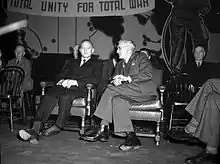
Victory Loan rallies were held at the Gardens during World War II.[20]
When Maple Leaf Gardens opened, it served as the home rink for all Toronto-based teams in the Ontario Hockey Association (OHA), except for the University of Toronto. OHA secretary George Dudley regularly renewed lease agreements to keep the same arrangement.[21]
On November 1, 1946, Maple Leaf Gardens was the site of the first game in the history of the Basketball Association of America (later to become the NBA), with the Toronto Huskies playing the New York Knickerbockers. The Huskies played their last game at the Gardens on March 28, 1947, and the franchise folded shortly thereafter. In the 1946–47 NHL season, Maple Leaf Gardens was the first arena in the NHL to have Plexiglas inserted in the end zones of the rink.[22]
Smythe became the majority owner of Maple Leaf Gardens Ltd. in 1947, following a power struggle between directors who supported him as president and those who wanted him replaced with Frank J. Selke. Toronto stock broker Percy Gardiner lent Smythe the money he needed to take control of the corporation. The loan was paid off in 1960.[23]
Beginning with the Canadian Grand Opera's production of Faust in 1936, the Gardens became home to more highbrow forms of entertainment. The Metropolitan Opera staged a number of its visiting productions there between 1952 and 1960.[24] The first rock and roll concert at the Gardens was held in 1956, featuring Bill Haley & His Comets. Elvis Presley's shows at the Gardens on April 2, 1957 were his first-ever concerts outside the United States. The Gardens also hosted evangelist Billy Graham during his Canadian Crusade, in 1955.[25]
Smythe-Ballard-Bassett in partnership: 1961–1971
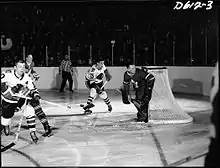
In 1961, Smythe sold most of his shares to a three-person partnership formed by his son, Stafford Smythe, with Harold Ballard and John Bassett. The new ownership added 962 new seats to the Gardens in 1962 and added a private club, The Hot Stove Club, the following year. Even more seats were added in 1965 and new mezzanine galleries were constructed in 1966 and 1967. By 1968, seating capacity for hockey had grown to 16,485.[26] This was achieved, in part, by making the seats narrower, so that—in the words of founder Conn Smythe—"only a young man could sit in them and only a fat old rich man could afford them." A large portrait of Queen Elizabeth II was removed to make room for more seats. When asked why he removed the picture, Ballard replied, "She doesn't pay me, I pay her. Besides, what the hell position can a queen play?"[27]
The Leafs were so popular that the team sold out every game from 1946 to 1999. It was often called the "Carlton Street Cashbox" in sports reporting. Advertising was sold and placed throughout the building.
On November 8, 1963: Maple Leaf Gardens would be the first arena in the NHL to have separate penalty boxes.[28] The Beatles made a stop at Maple Leaf Gardens during each of their three North American tours: September 7, 1964, August 17, 1965, and August 17, 1966. It was the only venue to host the group on each tour.
In March 1966, Conn Smythe resigned from the board of directors after a Muhammad Ali boxing match was scheduled for the Gardens. He found Ali's comments about the Vietnam War to be offensive and said that by accepting the fight, Gardens owners had "put cash ahead of class."[29]
The fight had been kicked out of every place in the U.S. because Clay is a draft dodger and a disgrace to his country. The Gardens was founded by men — sportsmen — who fought for their country. It is no place for those who want to evade conscription in their own country. The Gardens was built for many things, but not for picking up things that no one else wants[30]
— Conn Smythe, when informing John Bassett that he was resigning
Also in 1966, a new centre-hung scoreboard with a digital clock was installed replacing the SporTimer which was an analog clock. One of the designers of the new scoreboard, Paul Morris, was by this time the arena's public address announcer, a job he would hold until the Leafs left the arena.
Ballard and the younger Smythe were accused in 1969 of stealing money from the corporation and avoiding income taxes by having Maple Leaf Gardens Ltd. pay for many of their personal expenses.[31] The controversy created a rift between the two and Bassett, which led to Smythe and Ballard being fired from their management positions in 1969, only to win back control the following year. In September 1971, Bassett sold his shares to Stafford Smythe and Ballard. Just six weeks later, Smythe died. His brother and son tried to keep the shares within the Smythe family, but in February 1972 all of Smythe's shares were purchased by Ballard, leaving him with majority ownership of the building and the Leafs.
Harold Ballard takes control: 1972–1990

On July 7, 1974 the arena was the host of a Professional wrestling tournament which was called World Cup Wrestling. Various International stars competed in like Dara Singh, Pat Roach, Danny Lynch, Tiger Jeet Singh, Prince Mann Singh, Randhawa, Than Yen Chang, Majid Ackra, Kashmir Singh, Tony Parisi, Chris Tolos, Golden Boy Apollo, and Terry Yorkston etc. In the main event match, world champion Dara Singh defeated Danny Lynch and retained his title.[32][33]
Concert Promotions International was founded in 1973, by Bill Ballard, with Michael Cohl and David Wolinksy and brought many big-name music acts to the Gardens. The arena played host to The Rolling Thunder Revue Tour, with two consecutive shows, on December 1–2, 1975, headed by Bob Dylan. Bob Marley and The Wailers performed here on June 9, 1978 and November 1, 1979 in support of his Kaya Tour 1978 and Survival Tour 1979 respectively. The Bee Gees performed here on August 31, 1979. ABBA played here on Sunday, October 7, 1979, their last ever concert appearance in North America.[34] The Who performed what was supposed to be their last concert in December 1982 at this venue and was filmed for the concert film The Who Rocks America (1982). It was also at this venue where The Who performed their final concert to a paying audience with drummer Keith Moon on October 21, 1976. The Jacksons performed here on August 5, 1981 during their Triumph Tour. The video for The Reflex by Duran Duran was shot at Maple Leaf Gardens in March 1984. Hometown Canadian rock trio Rush recorded a live video for their Grace Under Pressure Tour at Maple Leaf Gardens. The arena played host to Amnesty International's legendary Human Rights Now! Benefit Concert on September 15, 1988. The show was headlined by Bruce Springsteen & The E Street Band and also featured Sting, Peter Gabriel, Tracy Chapman, Youssou N'Dour and k.d. lang. Pearl Jam performed at the arena on September 21, 1996 (the only Canadian date on the tour). From 1973 until the closing of Maple Leaf Gardens CPI brought the top rock and pop acts to Maple Leaf Gardens.[35]
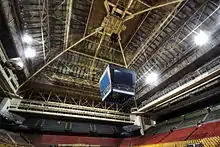
The Leafs continued to sell out every game through the Ballard era, even as the team's performance went into steep decline. The rink-side red seats were replaced with gold seats in 1974.[36] In August 1979, to make room for private boxes, Ballard had his staff tear down the 48-year-old gondola from which Foster Hewitt regularly broadcast games across Canada and threw it into an incinerator.[37] In an editorial, the Toronto Star called Ballard's actions the "barbaric destruction of one of Canada's great cultural monuments."[38] Then in 1982, the centre-hung scoreboard that had been in use since 1966 was replaced by a new centre-hung scoreboard with a colour matrix message/animation screen on each side, which remained in use for the rest of the Maple Leafs' stay at the Gardens. Originally an American Sign and Indicator scoreboard, it was upgraded by Daktronics in the 1990s.
Prior to the launch of the Ottawa Nationals of the World Hockey Association (WHA), the team had discussions with Ballard about locating the team in Toronto, but the talks did not get very far. The team was a flop at the box office, averaging about 3,000 fans a game, and in March 1973—just before the end of the season—the City of Ottawa demanded payment of $100,000 to guarantee the club dates at the Ottawa Civic Centre. The team decided to leave Ottawa and played their home playoff games at Maple Leaf Gardens, attracting crowds of 5,000 and 4,000 in two games before being eliminated by the New England Whalers. At the end of the season, the team moved to Toronto permanently, and was sold to John F. Bassett, son of former Leafs owner John Bassett. They were renamed the Toronto Toros in June 1973. Bassett wanted the team to play at a renovated CNE Coliseum, while Bill Ballard—Harold's son, who was running the Gardens while his father served a prison sentence—wanted the team at the Gardens and opposed the plan to upgrade the Coliseum. The Toros ended up at Varsity Arena for the 1973–74 season. The following season, the Toros moved to the Gardens after negotiating a lease with Bill. However, by the time the team played their first game at the Gardens, Harold had been released from prison and regained control of the company. Ballard was a virulent opponent of the WHA; he never forgave the upstart league for decimating the Leafs' roster in the early 1970s. He made the Toros' lease terms at the Gardens as onerous as possible. The Toros' lease called for them to pay $15,000 per game. However, much to Bassett's outrage, the arena was dim for their first game. It was then that Ballard demanded $3,500 for use of the lights. Ballard also denied the Toros access to the Leafs' locker room, forcing them to build their own at a cost of $55,000. He also removed the cushions from the home bench for Toros' games.[39] Following two seasons of declining attendance and onerous lease terms at the Gardens, Bassett moved the club to Birmingham, Alabama, where they were renamed the Birmingham Bulls for the 1976–77 season.
Sexual abuse
In 1997, allegations began to emerge that some employees of the Gardens had sexually abused young boys in the 1970s and 1980s. Martin Kruze was the first victim to come forward—contacting the new owners of Maple Leaf Gardens in 1993, and going public in February 1997. His story of abuses beginning in 1975 prompted dozens of other victims to come forward. In October 1997, Gordon Stuckless pleaded guilty to sexually abusing 24 boys dating back to 1969 and was sentenced to a jail term of two years less a day.[40] Three days later, Kruze committed suicide.[41] An appeals court later increased Stuckless' sentence to five years. He was paroled in 2001. In 1999, former usher John Paul Roby was convicted of sexually molesting 26 boys and one girl.[42] He was subsequently declared a dangerous offender and could have been kept in prison for the rest of his life. Roby died in Kingston Penitentiary from an apparent heart attack in 2001.[43] In 2002, former Gardens security guard Dennis Morin was found guilty of sexual assault, indecent assault and gross indecency for incidents involving teenage boys.[44] Allegations—unproven in court—were also made against other Gardens employees, including Ballard.[45] Several civil suits were settled out of court for undisclosed amounts. In January 2006, the Ontario government filed a $1.5 million lawsuit against Maple Leaf Sports & Entertainment Ltd., seeking repayment of the medical costs to the province of treating the sex abuse victims. Stuckless later died on April 9th, 2020 after suffering a brain hemorrhage a few nights before.[46]
Maple Leaf Sports & Entertainment: 1991–2003

Ballard died in April 1990. The executors of his will were Steve Stavro, Don Giffin and Don Crump. In 1991, Stavro paid off a $20 million loan that had been made to Ballard in 1980 by Molson. In return, he was given an option to buy Gardens shares from Ballard's estate. Molson also agreed to sell its stake in Maple Leaf Gardens Ltd. to Stavro. That deal closed in 1994, and shortly after, Stavro bought Ballard's shares from the estate for $34 a share or $75 million.[47] The purchase was the subject of a securities commission review and a lawsuit from Ballard's son Bill Ballard, but the deal stood and Stavro and his partners in MLG Ventures became the new owner of the Leafs and Maple Leaf Gardens.
MLG Ventures took Maple Leaf Gardens Ltd. private and the two corporations amalgamated.[48] becoming Maple Leaf Sports & Entertainment Ltd. after its acquisition of the Toronto Raptors in 1998. Initially, the majority owner of MLSE, holding 51% of the company, was MLG Holdings, a corporation controlled by Stavro, with minority shareholders Larry Tannenbaum (25%) and Toronto-Dominion Bank (20%). The other 49% of MLSE was owned by Ontario Teachers' Pension Plan. In 2003 Stavro sold his shares and MLG Holdings was dissolved, leaving Teachers' as majority owners of MLSE.
During the 1990s, MLSE considered a number of sites for a new, modern arena to replace Maple Leaf Gardens, including the southeast corner of Bay and Dundas Streets near the Toronto Eaton Centre (the current site of the Ryerson University School of Business). By this time, Maple Leaf Gardens was considered too small and lacking in revenue-generating luxury boxes.

The Leafs had no plans to occupy the Air Canada Centre, then under construction by the owners of the Toronto Raptors, and it appeared for a time as though the stalemate between the two sports franchises would result in two new arenas being constructed in Toronto – one for hockey, one for basketball. When MLSE acquired the Toronto Raptors, however, the Air Canada Centre, which was still under construction, was retrofitted to accommodate both hockey and basketball.
The Raptors played their final game at the Gardens on February 9, 1999. A few days later, on February 13, 1999, the Toronto Maple Leafs ended a 67-year tradition when they played their last game at Maple Leaf Gardens, suffering a 6–2 loss to the Chicago Blackhawks. Former Leaf Doug Gilmour scored a fluke goal in that game and notorious tough guy Bob Probert scored the final NHL goal in MLG history during the third period. During the emotional post-game ceremony, legendary Canadian singer Anne Murray performed The Maple Leaf Forever, clad in a Leafs jersey. Canadian band The Tragically Hip were the final musical artists to play at the venue.
The Gardens was the home arena for the Toronto Rock of the National Lacrosse League for the 1999 and 2000 seasons. The Rock won the Champion's Cup in both seasons, making them the building's last championship team. The 2000 NLL Championship game was ultimately the building's last professional event to be held at the MLG. They held training camp at the Gardens in 2001 and then moved to the ACC. Maple Leaf Gardens was then mostly dormant for a decade.
Loblaws and Ryerson (2004–present)
_(3294778069).jpg.webp)
MLSE refused to sell Maple Leaf Gardens to anyone who proposed to use it as an arena in competition with the Air Canada Centre. Among these turned down was Eugene Melnyk, owner of the Toronto St. Michael's Majors OHL hockey team and the Maple Leafs' rival team, the Ottawa Senators. Various redevelopment schemes were proposed, most notably an entertainment complex containing retail shops and cinemas (similar to the redevelopment of the Montreal Forum), but these plans were abandoned when it was discovered that the tiered arena seating was holding up the exterior walls of the building, acting as a form of interior flying buttress. If the bowl of seating were removed, therefore, the exterior walls would lose most of their support.
Loblaw Companies, Canada's largest food retailer, purchased the Gardens in 2004 for $12 million under the condition that it not be used as a sports and entertainment facility, though MLSE eventually consented to allowing a small arena to be restored in the building.[49][50] They were planning to convert the interior to accommodate a Real Canadian Superstore and parking. Immediately, there was criticism that the conversion of the building to retail uses diminished its heritage value, and that Maple Leaf Gardens should continue to serve as an arena in accordance with its rich history and traditions. Others, however, noted that the structure had been deteriorating for a number of years, and that its ongoing use for minor league sports and events would not generate sufficient income to secure the building's preservation and restoration. Furthermore, the active re-use of the building would allow it to remain open to the public for years to come.

Needing an authentic stand-in for New York's third Madison Square Garden during the Depression Era, the producers shot the boxing sequences of Cinderella Man (Russell Crowe and Renée Zellweger) at Maple Leaf Gardens in 2004. Maple Leaf Gardens was stripped of some of its outdoor signage for production of an episode of Canadian-produced Flashpoint. The arena was named "The Godwin Coliseum" in the episode titled "Behind the Blue Line" that originally aired on November 20, 2009.[51]
On September 8, 2009, Matt Damon hosted a concert in support of the charity ONEXONE. It was the first concert at Maple Leaf Gardens in 8 years. The arena was used on May 8, 2009 for the International Gay and Lesbian Travel Association's convention tradeshow. Also in 2009, the arena was used as the venue for the first season of Battle of the Blades, a CBC-produced reality competition pairing former NHL hockey players with professional figure skaters in a pairs figure skating competition.
In 2009, Loblaws announced it had entered into discussions with Ryerson University regarding the possible future joint use of the arena. On November 30, 2009, the federal government agreed to contribute $20 million as part of a $60 million project to renovate the arena into a Loblaws grocery store and a new athletic facility for Ryerson University which included a fitness facility, studios, high-performance courts, and an NHL-sized ice hockey rink seating approximately 2,796 guests. The plans involved gutting the existing interior, and laying new floors for retail use at ground level, with the athletic centre located above. Construction began later that year.

After many delays including finding a creek running through the basement and a time capsule behind the 1931 cornerstone on Carlton Street, the new store opened on November 30, 2011. It incorporated many elements of Maple Leaf Gardens including original seats, a red dot on the ground floor marking the original centre ice location, the recreation of an original mural by the checkouts and a giant maple leaf made out of old seats from the arena among numerous other things. The centre also includes underground parking, a Joe Fresh, an LCBO liquor store and a medical clinic. It is the chain's flagship location.[52] The transformation would win a World Architecture News Retail and Leisure Interiors Award in the "Retail outlets over 200 square metres (2,200 sq ft)" category.[53]
Mattamy Athletic Centre at the Gardens
.jpg.webp)
On November 29, 2011, Ryerson University announced that Peter Gilgan, Founder and Chief Executive Officer, Mattamy Homes Ltd., contributed a donation of $15 million to the university. In honour of Gilgan, the new athletic complex was renamed Mattamy Athletic Centre at the Gardens. The ice rink, which is located on the third level, was named Mattamy Home Ice.[54]
The athletic centre construction was completed in summer of 2012 and the ice rink became the new home for the Ryerson Rams hockey team. The first game took place on September 9, 2012, with the Rams taking a 5–4 victory over the University of Ontario Institute of Technology Ridgebacks.[55] The arena is home to the Ryerson Rams' hockey, basketball and volleyball teams.
During the Summer of 2012, the Canadian Lacrosse League announced the relocation of the Oshawa Machine to Toronto as the Toronto Shooting Stars. It was also announced that the team would play out of the Mattamy Athletic Centre bringing Lacrosse back to the Gardens after a 13-year absence. The team held their first game on January 13, 2013.[56] The pre-game honored former Toronto Rock and Tomahawk players. The team played one season at the arena before folding.
During the 2012–13 NHL lockout the National Hockey League Players' Association (NHLPA) used the arena for a charity game.[57] In addition, from January 25 to 27, 2013, the Ontario Liberals used the Gardens for their leadership convention.[58] The arena hosted the 2013 Players' Championship, a Capital One Grand Slam of Curling event. The facility also hosted the 2014 OUA Figure Skating Championships, won by the Guelph Gryphons.[59]
On December 13–14, 2014, the arena was the host of two exhibition games between the Canada men's national junior ice hockey team and a team University All Stars of combined Ryerson Rams, University of Toronto Varsity Blues and York Lions players in preparation for Canada's participation in the 2015 World Junior Ice Hockey Championships.[60]
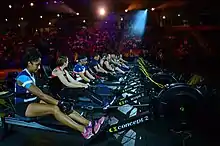
The arena, under the name Ryerson Athletic Centre, was one of the venues for the 2015 Pan American and Parapan American Games, hosting the basketball tournament of the 2015 Pan American Games, wheelchair basketball of the 2015 Parapan American Games[61] and various events (Indoor rowing, powerlifting, sitting volleyball, wheelchair basketball and wheelchair rugby) for the 2017 Invictus Games.
On February 13, 2018, the arena hosted an open practice for the Maple Leafs. This marked the first official Leafs event in the building since the last Leafs game played there in 1999 nineteen years to the day.[62]
Since opening in 2012, Mattamy Athletic Centre has hosted the 2015 CIS Men's Basketball Championship, the 2017 U Sports Women's Volleyball Championship and the 2019 U Sports Women's Basketball Championship.
Recognition
.jpg.webp)
Maple Leaf Gardens was named a National Historic Site of Canada in 2007 because it was:
one of the most renowned "shrines" in the history of hockey ... the largest arena in the country when it was built, it was one of the country's foremost venues for large-scale sporting events such as boxing matches and track meets, and non-sporting events such as concerts, rallies and political gatherings, religious services and opera ... the Gardens holds a special place in the country's popular culture: here Canadians welcomed a wide range of cultural icons from the Beatles to the Metropolitan Opera, from Tim Buck to Team Canada vs. the Soviets, from Winston Churchill to the Muhammad Ali-George Chuvalo fight.
The arena was also designated under the Ontario Heritage Act by the City of Toronto in 1991.[65]
Other teams
A list of other teams using Maple Leaf Gardens as their home:
- Toronto Lions 1931–1939 Ontario Hockey Association
- Toronto Marlboros 1931–1989 Ontario Hockey Association/Ontario Hockey League
- Toronto Young Rangers 1937–1948 Ontario Hockey Association/Ontario Hockey League
- Toronto Huskies 1946–1947 Basketball Association of America
- New York Rangers 1950 Stanley Cup Finals National Hockey League
- Toronto Knob Hill Farms 1962–1963 Metro Junior A League
- Buffalo Braves 1971–1975 National Basketball Association (16 home games)
- Ottawa Nationals 1972–1973 playoffs World Hockey Association
- Toronto Toros 1974–1976 World Hockey Association
- Toronto Tomahawks 1974 National Lacrosse League
- Toronto Blizzard 1980–1982 North American Soccer League
- Toronto Raptors 1997–1999 National Basketball Association (6 home games)
- Toronto Shooting Stars 1996–1997 National Professional Soccer League
- Toronto St. Michael's Majors 1997–2000 Ontario Hockey League
- Toronto Rock 1999–2000 National Lacrosse League
- Toronto Predators 2013- Greater Metro Junior A Hockey League
See also
- Cincinnati Gardens (modelled significantly on Maple Leaf Gardens)
- Coca-Cola Coliseum
- Harringay Arena (modelled significantly on Maple Leaf Gardens)
- List of indoor arenas in Canada
- Talbot Gardens (renovated on a design based on Maple Leaf Gardens during the 1990s)
- Varsity Arena
References
- Hornby, Lance (October 1, 1998). The Story of Maple Leaf Gardens. Sports Publishing LLC. p. 35. ISBN 978-1-58261-015-3. Retrieved February 28, 2013.
- "New Arena Work to Start on Saturday at Midnight". Toronto Star. May 30, 1931.
- Canadian inflation numbers based on Statistics Canada tables 18-10-0005-01 (formerly CANSIM 326-0021) "Consumer Price Index, annual average, not seasonally adjusted". Statistics Canada. November 15, 2020. Retrieved November 15, 2020. and 18-10-0004-13 "Consumer Price Index by product group, monthly, percentage change, not seasonally adjusted, Canada, provinces, Whitehorse, Yellowknife and Iqaluit". Statistics Canada. Retrieved November 15, 2020.
- "Maple Leaf Gardens Contract Goes to Local Firm". The Globe. Toronto. May 30, 1931.
- Flavelle, Dana (November 25, 2011). "Maple Leaf Gardens: From Shrine to Supermarket". Toronto Star. Retrieved November 25, 2011.
- "Mattamy Athletic Centre :: Venue Info". Mattamyathleticcentre.ca. Archived from the original on December 22, 2013. Retrieved January 22, 2014.
- Buffery, Steve (November 3, 2004). "The road was paved". Toronto Sun. Retrieved October 8, 2013.
- JIa, James (April 18, 2013). "Raptors wrap up season with best attendance in 4 years". Xinhua. Retrieved October 5, 2013.
- "Bucks Blast Raptors Home Opener". CBS News. December 13, 1999. Retrieved December 20, 2018.
- Smythe & Young 1981, p. 102.
- Smythe & Young 1981, p. 104.
- "Toronto Feature: Maple Leaf Gardens". thecanadianencyclopedia.ca. The Canadian Encyclopedia. Retrieved March 20, 2016.
- Maple Leaf Gardens, Limited – Prospectus, summary published in The Globe, March 5, 1931
- Smythe & Young 1981, p. 106.
- "Toronto's Maple Leaf Gardens gets C$60 million facelift". Reuters. December 1, 2009. Retrieved January 26, 2014.
- Beamish, Mike (February 13, 1999). "Maple Leaf Gardens 1931 – Air Canada Centre 1999: History vs. high tech: No design marvel, Air Canada Centre struggles to graft Gardens' history into a high-tech package that bucks the retro trend". The Vancouver Sun.
- "Saturday Night, Volume 96". Saturday Night. 1981. Retrieved August 1, 2015.
- Rodden, Mike (November 13, 1931) "Over Thirteen Thousand Attend Opening Game" The Globe
- "Winston Churchill". The Empire Club of Canada. Retrieved December 20, 2018.
- "The (Non Hockey) History of Toronto's Maple Leaf Gardens-Pre 1970s". The Vintage Inn. March 18, 2015. Retrieved September 29, 2020.
- "Sign Five-Year Contract With Gardens". Winnipeg Free Press. Winnipeg, Manitoba. November 22, 1937. p. 17.

- Hockey's Book of Firsts, p.66, James Duplacey, JG Press, ISBN 978-1-57215-037-9
- Smythe & Shea 2000.
- "Music at Maple Leaf Gardens". The Canadian Encyclopedia. March 4, 2015. Retrieved September 29, 2020.
- "Archived copy". Archived from the original on January 5, 2019. Retrieved April 9, 2016.CS1 maint: archived copy as title (link)
- Maple Leaf Gardens: Fifty Years Of History, Stan Obodiac, Van Nostrand Reinhold Ltd., 1981
- Houston, William (1984). Ballard: A Portrait of Canada's Most Controversial Sports Figure. Summerhill Press. p. 60.
- Hockey's Book of Firsts, p.72, James Duplacey, JG Press, ISBN 978-1-57215-037-9
- McKee, Ken (March 8, 1966). "'Cash Rated Over Class' Conn Quits". Toronto Star.
- Hunter 1997, p. 116.
- Lowman, Ron (July 9, 1969). "Staff Smythe and Harold Ballard Charged with Income Tax Evasions". Toronto Star.
- "MLG, Varsity, & The Singh's". Maple Leaf Wrestling. January 24, 2010.
- "Dara Singh – RIP…The Phantom of the Ring". Pro Wrestling Digest. July 23, 2012.
- ABBA: The Tour
- Bliss, Karen (March 17, 2014). "Bill Ballard, Legendary Canadian Live Producer and Promoter, Dies at 67". Billboard. Retrieved September 29, 2020.
- Obodiac 1981.
- Boulton, Rick (September 20, 1979). "Oh No! Ballard's Trashed Hewitt's Gondola". Toronto Star.
- "Editorial". Toronto Star. September 23, 1979.
- Hockey Trade Rumors – NHL Rumors from around the league – 37 Year Cup Drought – The Legacy of Harold Ballard Archived November 11, 2009, at the Wayback Machine
- "Sex Abuser Jailed Less Than 2 Years". Toronto Star. October 28, 1997. p. A1.
- "Kruze Jumps to Death from Bridge: He was First Victim to Tell of His Abuse in Stuckless Sex Scandal". The Hamilton Spectator. October 31, 1997. p. C1. Retrieved February 28, 2013.
- Pron, Nick; Edwards, Peter (May 10, 1999). "Roby Has Been Jailed Long Enough, Lawyer Says; Ex-Gardens Usher Convicted on 35 of 57 Sex Charges". Toronto Star. p. 1. Retrieved February 28, 2013.
- Pron, Nick (November 9, 2001). "Gardens Molester Dies in Prison". Toronto Star. p. B1. Retrieved February 28, 2013.
- Huffman, Tracy (December 13, 2002). "'Justice' in Gardens Sex Case: Maple Leaf Gardens Guard Assaulted Youths; Third Sex Crime Conviction of a Rink Worker". Toronto Star. p. B4. Retrieved February 28, 2013.
- van Rijn, Nicolaa (October 18, 2002). "Ballard Named in New Abuse Charges". Toronto Star. p. A3. Retrieved February 28, 2013.
- "Maple Leaf Gardens sex offender Gordon Stuckless dead, lawyer says - CBC News". CBC. April 10, 2020. Retrieved September 29, 2020.
- "Date-by-Date Story of Gardens Takeover Fight". The Hamilton Spectator. November 11, 1994. p. C15.
- osc.gov.on.ca Archived July 17, 2009, at the Wayback Machine
- Chu, Showwei (October 19, 2011). "Maple Leaf Gardens building renamed". CityNews. Retrieved January 16, 2014.
- Balkissoon, Denise (November 30, 2009). "Ryerson and Loblaws make a deal for Maple Leaf Gardens". Toronto Star. Retrieved January 16, 2014.
- Sniper in Maple Leaf Gardens Archived November 19, 2009, at the Wayback Machine
- Hopper, Tristin (November 21, 2011). "Maple Leaf Gardens Set to Reopen as Massive Supermarket". National Post. Toronto. Retrieved November 21, 2011.
- "World Architecture News Awards include Big Wins for TO and Canada". Urban Toronto. March 11, 2013. Retrieved March 7, 2014.
- Bradshaw, James (November 29, 2011). "Maple Leaf Gardens Gets a Makeover – and a New Name". The Globe and Mail. Toronto. Archived from the original on December 1, 2011. Retrieved November 29, 2011.
- Im, Grace (September 9, 2012). "Rams Wins First Game at the New Gardens". Toronto Observer. Retrieved September 9, 2012.
- "Canadian Lacrosse League". TorontoShootingStars.ca. Archived from the original on March 24, 2013. Retrieved October 22, 2015.
- "Locked-Out NHLers Take to the Ice at Former Maple Leaf Gardens for Charity". CBC News. The Canadian Press. December 19, 2012. Retrieved December 19, 2012.
- Ferguson, Rob (October 28, 2012). "Ontario Liberals: Ontario Liberal Leadership Convention Coming to Maple Leaf Gardens". Toronto Star. Retrieved February 28, 2013.
- Barrett, Jessica (February 14, 2014). "Gryphons claim OUA figure skating banner". Archived from the original on February 22, 2014. Retrieved February 15, 2014.
- "Canadian National Junior Team v University All Stars". Mattamy Athletic Centre. December 2014. Archived from the original on December 26, 2014. Retrieved December 14, 2014.
- "Ryerson Athletic Centre". TO2015. Retrieved September 18, 2014.
- Proteau, Adam (February 13, 2018). "Leafs mark anniversary of final game at Maple Leaf Gardens". Maple Leafs News. National Hockey League. Retrieved November 28, 2019.
- Maple Leaf Gardens, Directory of Designations of National Historic Significance of Canada
- Maple Leaf Gardens National Historic Site of Canada. Canadian Register of Historic Places. Retrieved August 18, 2011.
- City of Toronto Inventory of Heritage Properties
Sources
- Hunter, Douglas (1997). Champions: The Illustrated History of Hockey's Greatest Dynasties. Chicago, Illinois: Triumph Books. ISBN 1-57243-213-6.
- Obodiac, Stan (1981). Maple Leaf Gardens: Fifty Years Of History. Van Nostrand Reinhold Ltd.
- Smythe, Conn; Young, Scott (1981). Conn Smythe: If you can't beat 'em in the alley. Toronto, Ontario: McClelland and Stewart. ISBN 0-7710-9078-1.
- Smythe, Thomas Stafford; Shea, Kevin (2000). Centre Ice: The Smythe Family, the Gardens, and the Toronto Maple Leafs Hockey Club. Bolton, Ontario, Canada: Fenn Publishing Co. ISBN 1-55168-250-8.
External links
| Wikimedia Commons has media related to Maple Leaf Gardens. |